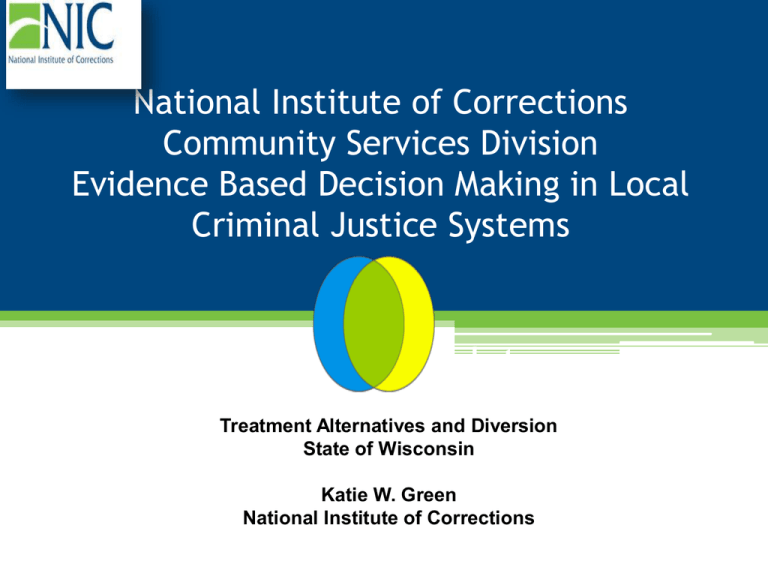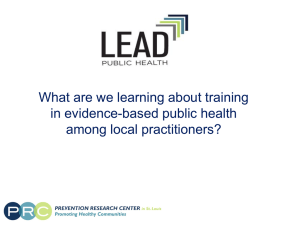Evidence Based Decision Making in Local Criminal Justice Systems
advertisement

National Institute of Corrections Community Services Division Evidence Based Decision Making in Local Criminal Justice Systems Initiative Update Treatment Alternatives and Diversion State of Wisconsin Katie W. Green National Institute of Corrections Overview • Evidence Based Decision Making in Local Criminal Justice Systems is an NIC initiative with an overall goal of implementing a framework that links protocols and information tools between decisions points of the Criminal Justice System and facilitates organizational change and Evidence Based Decisions among Criminal Justice Stakeholders. Why Evidence Based Decision Making? • The full potential of change has not yet been realized; these approaches have not been implemented system wide • A primary perceived barrier is the lack of system collaboration around a common set of outcomes and principles • There is a growing body of evidence that can inform justice system agencies’ performance and increase effectiveness Vision • To advance justice system policies and practices in ways that reduce harm and improve defendant and offender outcomes. • To build capacity within state exectutive teams to increase evidence based decisions and work collaboratively with their counties. Evidence Based Decision Making Initiative Phase 1 (2009-2010) Research Development of Framework Phase 2 (Sept 2010-Aug 2011) 7 Counties Technical Assistance Phase 3 7 County Implementation EBDM Sites Mesa County, Colorado Grant County, Indiana Ramsey County, Minnesota Yamhill County, Oregon Charlottesville-Albemarle County, Virginia • Eau Claire County, Wisconsin • Milwaukee County, Wisconsin • • • • • Principle #1 The professional judgment of criminal justice system decision makers is enhanced when informed by evidence-based knowledge. Examples: use of risk tools; effectiveness of interventions under certain conditions Evidence-based knowledge does not replace discretion but instead, informs decisions. Principle #2 Every interaction within the criminal justice system offers an opportunity to contribute to harm reduction. Examples: law enforcement officer at the point of arrest, pretrial officer at assessment, judicial officer on the bench To be effective, justice system players must understand how their interactions influence others and have the knowledge and skills to enhance this influence. Principle #3 Systems achieve better outcomes when they operate collaboratively at the individual, agency, and system levels Example: Establishment of policy teams and operational protocols that define how others will be consulted and decisions made Decision making responsibilities remain at the individual and agency level, however under the collaborative approach, input is received and other’s interests are taken into account. Principle #4 The criminal justice system will continually learn and improve when professionals make decisions based on the collection, analysis, and use of data and information Examples: Establishment of agency and system wide performance measures; feedback loops to examine efficacy of current practice Where evidence is not immediately available, the justice system may need to use its own data to determine what is or is not working. Key Decision Points Pretrial Status Decisions Arrest Decisions Local Institutional Release Decisions Charging Decisions Local Institutional Intervention Decisions Community Intervention Decisions Plea Decisions Sentencing Decisions Violation Response Decisions Discharge from Criminal Justice Intervention Phase II (Planning) Objectives Build a genuine, collaborative policy team Build individual agencies that are collaborative and in a state of readiness for change Understand current practice within each agency and across the system Understand and have the capacity to implement evidence-based practices Develop logic models Establish performance measures, determine outcomes, and develop a system scorecard Engage and gain the support of a broader set of stakeholders and the community Develop a strategic action plan for implementation Urban Institute: Evaluation of Phase II Research Report June 2012 Objectives Identify critical components of TA Document TA provision in the 7 EBDM sites Examine TA impact on site capacity and readiness Collaboration, coordination, knowledge development, support for EBDM Assess sites’ level of satisfaction with TA delivery Identify direct and indirect benefits, challenges, lessons learned Urban Institutes Evaluation Activitiesaluationluation Activities • Monthly phone interviews with core stakeholders Progress, impressions, critical needs • Site visits – twice to each site Policy team interviews, observe TA activities • Online stakeholder survey - 2 waves Collaboration/coordination, knowledge and support for EBDM principles, benefits of the initiative, satisfaction with TA, implementation readiness • Monthly TA activity reports • Document review and TA materials Evaluation Findings: Ample Evidence of Positive Impact Critical change targets identified in all 7 sites ▫ Facilitated robust strategic planning process ▫ Implementation on-going in all 7 sites Increased EBDM and system knowledge Increased knowledge and support for EBDM principles and practices Enhanced collaboration and coordination Indirect and direct benefits Essential TA elements identified Consensus on initiative’s key challenges Evaluation Findings: Phase III- Implementation Plans Common cross-site change targets Use of Proxy Screen at arrest to screen for risk of re-offense upon first interaction with law enforcement Use of Pretrial Risk Assessment to inform bail decisions and plea bargaining Incorporate risk information into PSI reports/sentencing decisions Target programming based on offender risk (in jail, probation/community supervision) Improve data collection/performance measurement systems Evaluation Findings: Critical Components of Technical Assistance • On-site monthly TA facilitation Engage stakeholders, facilitated collaboration Made research accessible Acted as liaison with other members of TA provider consortium • System mapping Develop knowledge of current practice and how EBP could improve system • Mini-assessments Substantive expertise to inform site EBDM implementation plan • EBDM education and system-wide training activities Main method of engaging agency staff in EBDM Evaluation Findings: Implementation Readiness for Phase III Measures of Readiness Agency Collaboration Coordination among Criminal Justice Agencies Stakeholder Engagement Coordination among Criminal Justice Leaders Support for EBDM Benefits of Initiative Overall Benefits of TA Overall Benefits of Phase II participation Individual Benefits of TA Stakeholder Survey • Online survey: 84 items and 9 demographic questions (about experience and role in CJ system, and EBDM involvement) • Targeted “key informants” across systems, not “insiders” • Mix of criminal justice partners, service providers, advocates, elected officials • Sample Ns and response rates vary by site • • • • Total Wave 1 N=248, Wave 2 N=216 Average site-specific N=35 (range = 19 to 64) Average Wave 1 response = 79% Average Wave 2 response = 68% • Analysis indicates respondents had extensive CJ experience, most had official role in EBDM (see handout) Eof Evidence of the Impact: Strong and Positive ImEpact is Strong, Positive Evaluation Findings: Capacity Building and Related Benefits • Support for EBDM Dramatic site-specific increases in support for EBDM principles Data collection and analysis as priorities at end of Phase II Some difficulty understanding research findings/applying them to local system EBP adaptation vs. adoption • Benefits of Phase II participation Huge emphasis on relationship building within sites – strengthening collaboration in leadership group Access to other TA resources (BJA’s Justice Reinvestment Initiative; CJCC network) Evaluation Findings: Collaboration and Leadership • Collaboration All sites started EBDM initiative with solid history of collaboration, all registered improvements over Phase II Formed working groups, subcommittees under EBDM policy team • Engagement Engagement increased for each stakeholder sphere in all sites Factors affecting stakeholder engagement in some sites Adversarial nature of criminal justice system (prosecutors, defense attorneys) Offender-focus of initiative (law enforcement, prosecutors) • Leadership Broad involvement from leaders across the CJ system Policy team chairs provided critical leadership Were useful in bringing more reluctant stakeholders to EBDM table Implications for Phase III • Increase focus on data collection and performance measurement • Prioritize agency staff engagement • Concentrate on community engagement • Address challenges related to the adversarial nature of the criminal justice system, identify “win-win” themes ▫ Implications for stakeholder engagement ▫ Implications for implementation and sustainability • Identify peer-to-peer learning opportunities ▫ Difficult to address in Phase II because of competition Urban Institute: Recommendations • Continue targeted TA, emphasis on team facilitation • Prioritize and facilitate data collection, analysis & measurement • Make research more accessible • Provide structured opportunities for peer learning ▫ Weigh cost/benefits of competition carefully • Use policy team leadership position strategically • Balance timeline with level of effort • Consider additional evaluation Phase III (Implementation) Objectives Collect baseline data on implementation strategies Implement change strategies Sustain a multi-disciplinary collaborative policy team Fully engage agency staff in EBDM, focusing specifically on agency managers and supervisors Embed EBDM knowledge systemwide Carry out the external stakeholder communication strategy Guard against implementation failure Measure performance against systemwide scorecard Celebrate success Institutionalize policy changes Expand the number of EBDM change strategies Educate and engage in-state colleagues on EBDM Share experiences with national colleagues What’s next for EBDM? • Change Targets Added during Phase III ▫ Diversion ▫ Moving down in the organizations • Publications ▫ Revised Framework including reentry decision points ▫ Case Studies/Stakeholder lessons • Communication Strategy: Risk Communication • Sustainability Plans/ Exit Strategies • Statewide Implementation ▫ State Level Summit: October ’13 Held in State of Wisconsin ▫ Select State and County, through competitive process to receive NIC technical assistance- March ‘14 Tools • The Framework: http://www.cepp.com/documents/EBDM%20Framework.pdf • EBDM Starter Kit: ▫ Purpose: Provides guidance to sites that want to prepare to implement EBDM in their own jurisdictions ▫ Audience: Local, collaborative criminal justice teams http://ebdmoneless.org/starterkit/ • EBDM User’s Guides: ▫ Purpose: Provide guidance to specific stakeholder groups on how EBDM applies to their work, common challenges, solutions and resources ▫ Audience: Pretrial Justice Prosecutors Judges Defense Victims Stakeholder Publications Site Case Studies • EBDM website • http://ebdmoneless.org/ • EBDM Starter Kit • http://ebdmoneless.org/starterkit/ •










